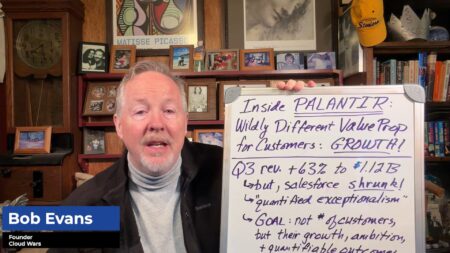As the relationship between manufacturing and retail gets closer and the two become more dependent on each other, it’s vital to use multiple cloud computing platforms to effectively manage and respond to changing business needs.
As CIO of a mid-market manufacturing company, I have experienced first-hand the evolution of the supply chain and logistics field in recent years. Consumers demand that the latest products be delivered immediately, straight to their doors.
This expectation puts tremendous pressure on all the participants in the supply chain and presents significant challenges when that supply chain spans multiple countries and continents. Add sustainability initiatives into the mix, and it becomes clear that a comprehensive strategy is needed. One of the primary ways that companies are solving this problem is through on-demand manufacturing powered by multi-cloud technology.
On-Demand Manufacturing Benefits
On-demand manufacturing addresses these market pressures, resulting in reduced costs, increased cash flow, and streamlined operations. With on-demand manufacturing, companies can produce products only when they are needed, rather than producing products in advance and storing them in inventory.
For example, IKEA recently launched a line of on-demand 3D-printed decorative items. Additive manufacturing supply chain solution provider WAZP, which helped IKEA deliver its on-demand products, is finding a rapidly growing demand for such technologies.
Here is a more detailed look at the benefits of on-demand manufacturing:
Reduced Waste
With on-demand manufacturing, manufacturers produce only the products that are needed, rather than producing a large number of products and having to dispose of unsold items. This is an important part of any sustainability initiative and, along with recycling, helps to lower the need for landfill space. At my company, Paragon Films, we take sustainability and the environment seriously, so any process improvements that reduce waste are squarely in line with our core values.
Flexibility
On-demand manufacturing allows companies to be more flexible and adapt quickly to changes in demand. This can help to lower inventory costs by reducing the amount of inventory that is produced and stored when demand is low. At Paragon, warehouse space is at a premium. Not only is it expensive to buy or rent space, it can also be difficult to scale space up or down quickly. An effective on-demand manufacturing process helps to ensure that little product needs to be stored, since it is shipped quickly after coming off the manufacturing line.
Customization
On-demand manufacturing can also offer the ability to customize products to specific customer needs, which can help to lower inventory costs by reducing the need to store large quantities of a single product. Companies can also produce made-to-order products, such as furniture or equipment, which can help to increase customer satisfaction by allowing them to create products that are truly unique. They can also produce small-batch products that are tailored to niche markets.
Supply Chain Visibility
Manufacturers can improve supply chain visibility using real-time data analysis. That data can be passed into automated inventory management systems, which can automatically adjust production schedules to match demand. They can also leverage advanced technologies such as artificial intelligence (AI), machine learning, and predictive analytics for more accurate predictions of future demand.
How Does Multi-Cloud Optimize Supply Chain Operations?
On-demand manufacturing is a powerful way for retail companies to get products to their customers quickly, and multi-cloud technology provides important capabilities to achieve those goals. A multi-cloud approach can help retail companies to optimize their supply chain operations by providing the best available tools and systems to manage resources and communications between different companies, while also improving scalability, security, and disaster recovery.
A multi-cloud solution allows companies to take advantage of different cloud providers’ strengths, such as data analytics and artificial intelligence (AI) capabilities, while still maintaining flexibility and control over their data and operations. For example, a company may use one cloud provider for its data analytics needs and another for its enterprise resource planning (ERP) system. This allows it to take advantage of the best-of-breed solutions from different providers and tailor their technology stack to their specific needs.
Here are a few other benefits of multi-cloud:
Scalability
Manufacturing companies often experience fluctuations in demand and require the ability to scale their resources quickly and efficiently. A multi-cloud strategy allows companies to take advantage of the different scalability options offered by different cloud providers, such as automatically scaling resources based on demand or provisioning additional resources as needed. This can help to ensure that the company’s operations can continue to run smoothly and efficiently, even during periods of high demand.
Security
Manufacturing companies often handle sensitive data, such as customer information and production data, that needs to be protected. A multi-cloud strategy allows companies to take advantage of different security features and services offered by different cloud providers, such as identity and access management, encryption, and threat detection and response. This can help to ensure that the company’s data is secure and that the company is compliant with relevant security regulations, many of which vary by country or region.
Disaster Recovery
Manufacturers need to ensure that their operations can continue in case of a disaster — whether natural or man-made. A multi-cloud strategy allows companies to take advantage of the different disaster recovery options offered by different cloud providers, such as automated backups, disaster-recovery-as-a-service (DRaaS), and geo-redundancy. By distributing workloads and data across different cloud providers, a company can minimize the risk of a single point of failure and ensure that its operations are able to continue even in the event of a disruption, minimizing the potential impact on the company’s customers, employees, and shareholders.
Go Deeper
On-demand manufacturing has proven to be a valuable addition to the supply chains of both manufacturers and retailers, as it allows for reduced costs, increased cash flow, and streamlined operations. The ability to only produce products as they are needed, rather than producing products in advance and storing them in inventory, can lower inventory costs and help companies to be more flexible and adapt quickly to changes in demand.
Additionally, on-demand manufacturing allows for the ability to customize products to specific customer needs and improve supply chain visibility through real-time data analysis. A multi-cloud strategy can further enhance the benefits of on-demand manufacturing by providing the best available tools and systems to manage companies and resources, while also improving scalability, security, and disaster recovery. For a deeper dive into multi-cloud technology and the cloud providers involved, check out the wide range of articles and videos on multi-cloud by Acceleration Economy analysts.
Want more tech insights for the top execs? Visit the Leadership channel:










